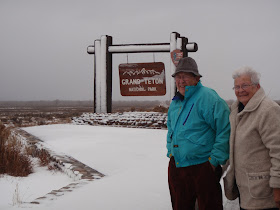After Dad set the magazine aside I asked the question he had come to expect every summer: "How about a list of places you and Mom would like to see in 2016?" Although my parents still reminisced and recalled special moments from previous international journeys, lately they'd limited their travel destinations to North America.
Dad thought for a moment. "Well, let's see," he said, "I've never been to Montana. Then there's the Columbia River Gorge. The Florida Keys would be nice. Or, how about Nova Scotia?" Now Mom chimed in: "Oh yes, " she added, "I've always wanted to see Nova Scotia."
At ages 86 and 85 Dad and Mom didn't get around as well as they used to. And even though Dad hadn't been feeling quite himself lately, we had recently returned from a trip to South Carolina, Georgia and Florida. As for Canada, their passports were current; they were ready to go!
That settled it. "Come January," I said, "I'll start the Nova Scotia trip-planning."
Cancer, however, had other plans. Cruel, heartless, unforgiving plans.
Less than three months later, on a bright blue October day, Dad was gone.
****
Dad was a fan of my blog and eagerly awaited each new post. He and Mom had never bought a computer so I printed the blogs and mailed them copies. Dad always commented on my posts but my readers never saw his reviews online; he commented the old-fashioned way—over the telephone.
I will miss that.
****
I suppose it's the ultimate tribute to say of someone that at the age of eighty-six he was "gone too soon". But my Dad still had enthusiasm for life and for travel. He had places to go and things to do! Below are some photos from the past several years of travel with my parents. Gone too soon. Indeed.
 |
| July 2015. Surrey-riding on the boardwalk at Ocean City, New Jersey. |
 |
| March 2015. Enjoying the sight of thousands of blooming azaleas at Wesley Memorial Gardens, St. Simon's Island, Georgia. |
 |
| December 2013. Not just fair-weather travelers! My parents toughed out a zero degree day in Jackson Hole and the Grand Tetons. |
 |
| June 2014. Dad always looked forward to sampling the regional cuisine of the places he traveled to. At Doc Martin's Restaurant in Taos, New Mexico we savor an authentic southwestern meal. |
 |
| June 2014. Ready to roll. Relaxing at the Old Santa Fe Inn before traveling to the next New Mexico destination. |
 |
| June 2014. Ah, the good life. Taking a break at the Adobe and Pines Inn, Taos, New Mexico. |


































.jpg)










